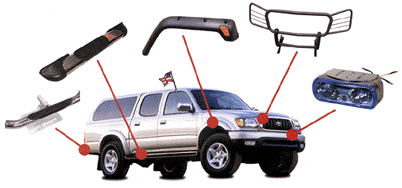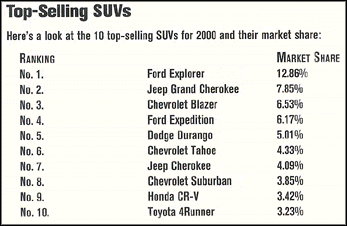Americans bought more than 3.4 million SUVs in 2000 and then spent an additional $1.59 billion to accessorize and personalize them. You’re already repairing these vehicles. Maybe it’s time to consider upselling their owners on accessories as well. Someone is going to.

It’s official. The SUV is the king of the road.
This sporty and now sometimes luxurious vehicle got its roots in 1935 when Chevrolet introduced its light-on-luxury-heavy-on-utility Suburban Carryall, which many credit as the original sport utility. As we all know, many other utility vehicles followed.
“A number of brands were definite sport utilities and were introduced in the ’60s, ’70s and ’80s, such as the Bronco, Toyota Land Cruiser, International Scout, Jeep Wrangler, Land Rover Defender and others,” says “Truckin’ SUV” magazine editor Carl Calvert. “A number of experts say the first modern SUV was the Ford Explorer, which I believe was introduced in 1990.”
Believe it or not, just two decades ago, there were a lot more Rubik’s Cubes on the market than SUVs. In 1980, auto makers sold just a little more than 250,000 SUVs in the United States, while millions of Rubik’s Cubes were frustrating people around the globe. Twenty years later, however, closer to 3 million SUVs were sold that year, while most Rubik’s Cubes had long since been thrown away, thrown against a wall till they were unrecognizable or purposely run over by someone driving an SUV.
In 1980, SUVs accounted for just 1 percent of the automobile market. By 1995, SUVs made up 12 percent of the market and, in 2000, more than 50 percent of the market was comprised of light trucks and SUVs.
But these aren’t the heavy-duty farm and utility vehicles like the original Suburban. Though some are practical, others are fun.
Name a car maker and you’ll likely find an SUV sporting its name. Everyone from GM and Ford to Nissan and Toyota to Mercedes and BMW has at least one sport utility on the market. And in the fall, even Porsche will enter the world of SUVs with its Cayenne sport utility. And let’s not forget truck-based designs like the Lincoln Navigator and Cadillac Escalade or car designs like the Subaru Legacy and the BMW X-5.
However, Ford has estimated auto makers will pour even more SUV models into the mix over the next few years – from approximately 45 in 2000 to 70 by 2005. GM has been equally optimistic in its expectations for the near future, estimating SUVs will outsell every automobile segment in the United States by 2005.
With millions of new SUVs on the road each year nationwide and with so many people excited to drive what GM calls these “must-have products,” many SUVs are bound to come through your doors for repair work.
Enter a bold opportunity.
Body shops like yours have a distinct opportunity to capitalize on a niche market – accessories for the SUV. If SUVs are coming into your shop for repairs anyway, why not upsell customers on things like grille guards or bike racks, which they’ll likely end up buying at some point anyway? On the other hand, sell to someone who isn’t in the market for a repair, and maybe that person will remember you when he is in an accident.
The SUV Accessory Market
For each SUV, there’s likely an enthusiasts club – a group of SUV owners who love their trucks enough to actually join a club to celebrate it. The members are the kind of people who take vacations that include their vehicles. They plan adventurous outings and off-roading weekends. They spend money so they can spend more time in their vehicles. And they spend money on accessories. Some of these accessories are cosmetic and personalize their vehicles; others are just plain practical.
But it’s not just your outdoorsy-types cruising the streets in SUVs these days. Your typical SUV owner could be a mother of three, a CEO or a 19-year-old college student. For some, it’s the look. For others, it’s size and cargo area. And for others still, it’s the luxury.
SUVs are just plain popular. In 2000, consumers purchased 3.4 million SUVs. That’s the year men buying new vehicles chose SUVs over any other vehicle, including pickups. In 2001, SUVs became the favorite for female new car buyers as well, according to R.L. Polk & Co., the Michigan-based automotive research firm. SUVs accounted for 23.9 percent of the female new-car buyers market, while continuing to top the male market at 25 percent.
So how do SUV sales and accessory sales come together? Just ask the Specialty Equipment Market Association (SEMA). The restyling market in 2000 generated approximately $3.1 ($3.058) billion in sales at retail outlets, according to Jim Spoonhower, SEMA vice president of research and information. Of that market, a Frost & Sullivan research study shows accessories for SUVs, minivans and pickup trucks (which make up the light truck market) generated $1.59 billion in 2000. The firm estimates steady growth will continue, reaching $1.89 billion by 2007.
Why not take your cut of this continually expanding market?
“The changing demographic profile of light-truck owners has helped increase the demand for accessories that combine function with style,” says Frost & Sullivan analyst Jasmine Sachdeva. “Light trucks are becoming vehicles of choice for many consumers, moving away from its traditional base.”
According to Sachdeva, most light truck accessories serve a functional purpose for the owner of the vehicle and provide an instant aesthetic face-lift. It’s the ability to combine both elements that increases the appeal of the aftermarket accessories for end-users.
And what consumers buy to personalize their vehicles is as varied as their reasons for buying an SUV. According to SEMA, among the top accessories for SUVs are roof racks and tow hitches, which together generated more than $112 million in 2000. But the aftermarket is expansive, so the choices for accessories don’t stop there. Many, many accessories are available – some for safety, some for luxury and some for style.
“A little accessory area in the shop would be a good move [for body shop owners],” says Bill Brouse, CEO of Minnesota-based Brouse Co. LLC., which owns the Sport Utility Vehicles Owners Association.
Even Brouse admits to having one aftermarket accessory on his Jeep that he couldn’t live without: a sensor that alerts the driver if there’s anything in the SUV’s path when it’s backing up. “It’ll pick up something you can’t see like a fireplug or a bicycle or a child – God forbid,” says Brouse. “It gives off a steady beep inside the car.” It’s loud enough to warn the driver but, as Brouse points out, not so loud that it sounds like a garbage truck backing up.
But safety isn’t the only reason SUV owners buy accessories. Some of the most popular truck accessories – besides roof racks and tow hitches – are bedliners, hood and side window deflectors, rear sliding windows and toolboxes, according to a SEMA consumer survey.
“Appearance accessories sales continue to grow,” says Spoonhower. “Products for trucks dominate the accessory market, with domestic truck products taking 65 percent of the segment, and import trucks taking 10 percent. That means that $3 out of $4 spent on accessories are spent for truck, van and SUV accessories.”

Writer Cheryl McMullen is associate editor of Bodyshop Business.
For more on the restyle market, log on to www.bodyshopbusiness.com and click on “Web-Exclusive Features.” You’ll find out how SEMA is raising the bar with restyle-specific certification testing.













